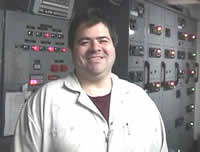|
Participant Perspective - July
25, 2001
 Interview
with Mike Gowan Interview
with Mike Gowan
Acting Chief Marine Engineer - NOAA Ship RONALD H. BROWN
Jeff
G: What are your duties aboard the RON BROWN?
Mike:
I'm responsible for the operation and maintenance of this vessel. It's
pretty broad. I have three engineering officers that keep me informed
about what's going on in terms of the propulsion and electrical generation
systems. There are six diesel generators. Three of them can supply only
propulsion. The other three can provide propulsion or ship service, lighting,
pumps, motors, air conditioning etc. Three of the engines are 1500 kWt.
One of those would provide enough electricity for 50 homes. This ship
could basically power a small city of maybe about 20,000 people. It takes
a lot of power to move this ship through the water.
Jeff:
How does the Brown compare to other ships you've been on?
Mike:
There's a big difference in ship construction between the newer and older
NOAA ships. The older vessels were built a lot heavier and stronger. There's
a lot more material and strength in their hulls and they were built from
the keel up. Newer vessels like this one are almost like a factory-built
home. They're built using modular construction and the pieces are put
together. Modular built vessels are cheaper to build but they don't last
as long. The Discover, a NOAA vessel built in 1966, had about the same
amount of horsepower as this vessel. It was 1000 tons heavier and 25 feet
longer but it could do 16 or 17 knots (Brown can do about 12 knots) due
to hull design and a propulsion system design. The thrusters used on the
Brown aren't really made for speed. They're made for maneuverability.
So, the Brown was designed to sit and be maneuverable on station. It's
the best in the NOAA fleet at doing that. It has a dynamic positioning
system and three thrusters, a bow thruster and two stern thrusters. It
holds the ship within a couple of meters of one point in up to about 35
knot winds and fifteen foot seas. At that point you have to watch closely
to maintain a location.
Jeff: What
do you like most about being an engineer for the Brown?
Mike:
I like the variety. I never stuck working on one thing. If I were doing
the same type of job on land I'd be in charge of operation and maintenance
for something like a skyscraper. It's very similar because you've got
pumps, piping systems, controls, generators, air conditioning units, etc.
It's almost exactly the same thing but you have to fight through traffic
to get there, fight through traffic to get home and someone's always calling
you. I prefer to be out here, or on vacation. I like working for NOAA
too. If I were on an oil tanker I'd go from point A to point B, offload,
go back to point A, take on cargo, then go back to point A and offload.
Here, we do a lot of different things. That's the deal on me.
|

